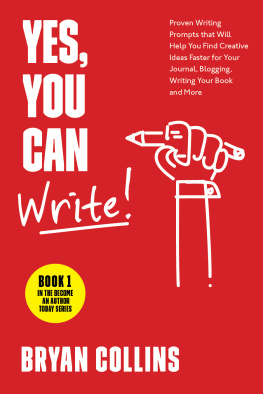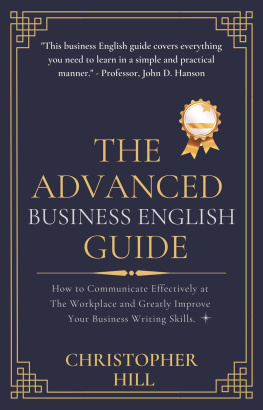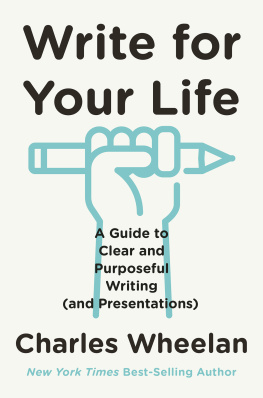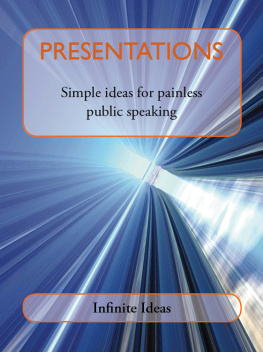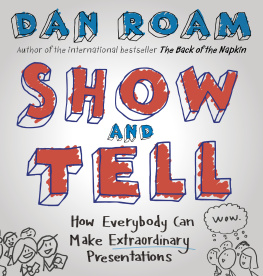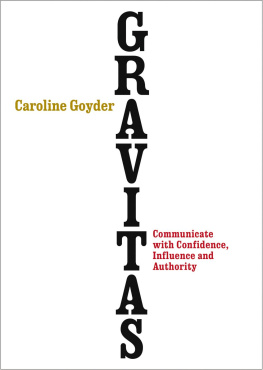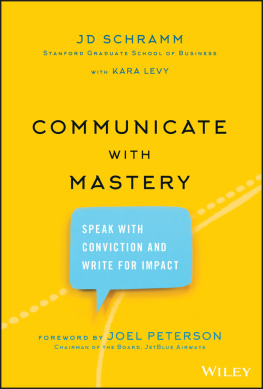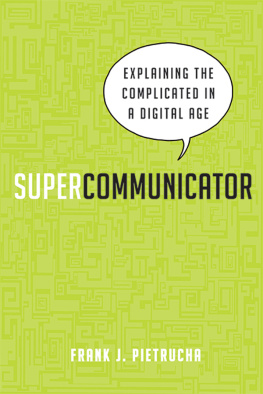Explain your Vision. The problem is to understand human intelligence. The idea is to model human story-processing.
what problems to work on. Pictures of the quoted give life to the slide.
Lenny Skutnik, used as a human prop.
Video courtesy of Ronald Reagan Library.
courtesy of Gerald Jay Sussman.
swipe of my hand.
Il Redentore filling the entire slide.
Foreword by Gill Pratt
Communication is, without question, the most important enabler of human civilization.
Without our sophisticated ability to communicate, we would still be living in caves, desperately searching for resources, while living in fear of predators.
Every man-made thing, from cars to computers to poetry, results from communication.
And yet, the communication bandwidth between human beings is limited to rates on the order of 10 bits per second of Shannon entropy. This rate is astonishingly lowabout the same whether we communicate through voice or through writing. By comparison, even ordinary personal computers today can communicate with one another at a gigabit per second100 million times faster than human communication.
You can think of Shannon entropy as the amount of information that results from the most effective possible compression.
How do we overcome our extraordinary communication bandwidth limitation?
We do so by exploiting the subject of this bookour ability to tell stories that evoke imagination.
Whenever a speaker communicates with a listener, the speaker evokes in the listeners mind a picturea modelof what is being described. The speakers words guide the listeners model, assembling in their mind complex ideas drawn from the shared heritage and experience of the speaker and listener.
I use the words speaker and listener interchangeably with writer and reader, respectively.
This model-based communication technique serves the function of compression, with the shared heritage and experiences of both parties playing the role of the constellation of code words used in typical computational data compression.
So, part of the art of effective human communications is the art of compressing data to get through an incredibly small 10 bit/s bottleneck.
The other part of effective communication is holding your audiences interest by having a model of their emotional mind, and evoking and steering their emotions with skill.
There have been few practitioners of both parts of this art more intelligent, capable, and kind than this books author, Patrick Henry Winston.
I knew Patrick for 40 years, from my arrival at MIT as a freshman in 1979 to a few days before his passing in 2019, when I had the good fortune of talking to him about communication one last time. Despite the stark setting of his hospital room and illness, we spoke about many things.
First, how the order of 10 bits/s limit seems to exist even for esoteric modes of human communication, like EEG.
We spoke about how even our visual system may not convey any higher Shannon entropy due to the compression of retinal images into cognitive meaning by the visual cortex. We discussed how several organizations, including DARPA and startups like Neuralink, are exploring whether novel brain interfaces can surpass this limit. We were both skeptical. Perhaps the cognitive part of our brain faces fundamental limits of input/output information bandwidth that render it impossible to easily surpass the efficiency of normal human communication.
We spoke finally about the second part of communication beyond data compressionthe art of storytelling and the skill of accurately estimating a listeners state of mind and telling a story in a way to elicit interest. We spoke about how understanding the human mind well enough to draw engagement and focus from ones audience remains a rare, but teachable skill.
Patrick taught many of us this art. We learned it by listening to him lecture, and by listening to him lecture about lecturing.
It is hard to describe the joy of being a student of a great teacher. I had the fortune of having Patrick as my greatest teacher of communication. As is true for many others, I owe Patrick a great deal, and I use the lessons he taught me every day.
I cannot imagine a better teacher of this subject than Patrick, or a better storyteller on the art of storytelling.
You are in for a treat.
Gill Pratt
SB 83, SM 87, PhD 89
Electrical Engineering and Computer Science
Massachusetts Institute of Technology
CEO, Toyota Research Institute
Fellow, Toyota Motor Corporation
Acknowledgments
I am much indebted to Karen Prendergast and Sarah Winston for their myriad suggestions, all of which I accepted, with varying degrees of grace.
Paul Keel and Chiai Takahashi provided many structure, layout, and content suggestions. Gill Pratt generously contributed the Foreword.
Many others offered major suggestions about content. These include: Robert Berwick, Robert Birnbaum, Philippe Brou, Randall Davis, Delores Etter, Mark Finlayson, Kathleen Freeman, Ellen Hildreth, Dylan Holmes, Boris Katz, Kimberle Koile, Adam Kraft, Henry Lieberman, David Martinez, Joel Moses, Peggy Moses, Gerald Jay Sussman, Julie Sussman, Peter Szolovits, Michael Telson, Gaurav Tewari, Hector Vazquez, David Wilcox, Rob Wesson, and Zhutian Yang.
I am especially grateful to Janey Pratt, who provided valuable advice and encouragement.
Prologue: You Will Be Empowered
You will learn how to speak and write well from this book. The return on the time you invest in acquiring knowledge about how to communicate will be bigger than the return on any other investment you make.
In this chapter, you learn that there are principles that apply to all kinds of communication, both spoken and written. If you make use of just one principle from reading this book, that principle may be the life-changing one that gets you the job, wins the award, brings in the grant or contract, makes the sale, convinces your boss, excites the venture capitalist, inspires a student, or starts a revolution.
If you persuade or instruct, speak or write, this book is for you
You persuade and instruct if you work in business, especially in sales and marketing. You persuade and instruct if you train or educate, if you do research in anything from anthropology to zoology, if you are in defense or law enforcement, if you are a student eager to get a good grade, if you preach or run a non-profit organization, and certainly if you practice law, medicine, architecture, or journalism. All these have much in common. All involve moving ideas from you to your audience.
As you persuade and instruct, you will speak and write. Many present with slides or help prepare such presentations. Some lecture, question witnesses, or run for office. Some write scholarly papers, compose position papers, construct legal briefs, or develop business plans. All these have much in common.


